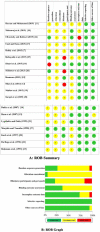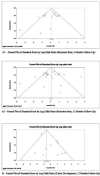Comparison of the Success Rate of Filled and Unfilled Resin-Based Fissure Sealants: A Systematic Review and Meta-Analysis
- PMID: 35937149
- PMCID: PMC9294718
- DOI: 10.18502/fid.v19i10.8855
Comparison of the Success Rate of Filled and Unfilled Resin-Based Fissure Sealants: A Systematic Review and Meta-Analysis
Abstract
Objectives: Incorporation of fillers might improve the physical properties of sealants. This systematic review and meta-analysis evaluated the retention and caries development rate of filled and unfilled fissure sealants. Materials and Methods: This study was conducted according to the Preferred Reporting Items for Systematic Reviews and Meta-Analysis guidelines. The PubMed, Scopus, Embase, Cochrane Database of Systematic Reviews, and ISI Web of Knowledge were searched until October 24, 2019. The risk of bias (ROB) was assessed for the included studies based on the Cochrane collaboration common scheme for bias, and the meta-analysis was performed through a random effects model. Results: The search resulted in 6,336 unrepeated relevant studies. After the title, abstract and full-text screening, 19 studies with 26 comparing groups were finally included in this systematic review and meta-analysis. According to the included studies, both retention rate and caries development in filled and unfilled resin-based sealants did not significantly differ within 2 years of follow-up. Conclusion: Since there was no significant difference in the retention rate and caries development between filled and unfilled sealants, it seems that the final decision should be made uniquely for each patient according to the type of fissure, patient's age, habits, etc.
Keywords: Composite Resins; Meta-Analysis as Topic; Pit and Fissure Sealants.
Copyright © 2022 The Authors. Published by Tehran University of Medical Sciences.
Figures





Similar articles
-
Retention of flowable composite resins in comparison to pit and fissure sealants: a systematic review and meta-analysis.Gen Dent. 2020 Jul-Aug;68(4):50-55. Gen Dent. 2020. PMID: 32597778
-
Retention of resin-based filled and unfilled pit and fissure sealants: A comparative clinical study.Contemp Clin Dent. 2015 Mar;6(Suppl 1):S18-23. doi: 10.4103/0976-237X.152932. Contemp Clin Dent. 2015. PMID: 25821368 Free PMC article.
-
Retention of pit and fissure sealants versus flowable composites in permanent teeth: A systematic review.Heliyon. 2020 Sep 24;6(9):e04964. doi: 10.1016/j.heliyon.2020.e04964. eCollection 2020 Sep. Heliyon. 2020. PMID: 33005790 Free PMC article. Review.
-
In Vitro Microleakage Comparison of Flowable Nanocomposites and Conventional Materials Used in Pit and Fissure Sealant Therapy.Front Dent. 2019 Jan-Feb;16(1):21-30. doi: 10.18502/fid.v16i1.1105. Epub 2019 Jan 20. Front Dent. 2019. PMID: 31608333 Free PMC article.
-
Effectiveness of Pit and Fissure Sealants for Preventing and Arresting Occlusal Caries in Primary Molars: A Systematic Review and Meta-Analysis.J Evid Based Dent Pract. 2020 Jun;20(2):101404. doi: 10.1016/j.jebdp.2020.101404. Epub 2020 Jan 29. J Evid Based Dent Pract. 2020. PMID: 32473795
Cited by
-
Clinical effectiveness of pit and fissure sealants in primary and permanent teeth of children and adolescents: an umbrella review.Eur Arch Paediatr Dent. 2024 Jun;25(3):289-315. doi: 10.1007/s40368-024-00876-9. Epub 2024 Mar 15. Eur Arch Paediatr Dent. 2024. PMID: 38488955 Free PMC article.
-
Evaluation of the effectiveness of prophylactic sealing of pits and fissures of permanent teeth with fissure sealants - umbrella review.BMC Oral Health. 2023 Oct 27;23(1):806. doi: 10.1186/s12903-023-03499-6. BMC Oral Health. 2023. PMID: 37891656 Free PMC article.
-
Comparison of the clinical performance of self-adhering flowable composite and resin-based pit and fissure sealant: a randomized clinical trial in pediatric patients.BMC Oral Health. 2024 Aug 14;24(1):943. doi: 10.1186/s12903-024-04449-6. BMC Oral Health. 2024. PMID: 39143632 Free PMC article. Clinical Trial.
References
-
- Yazici AR1, Karaman E, Baseren M, Tuncer D, Yazici E US. Clinical evaluation of a nanofilled fissure sealant placed with different adhesive systems: 24-month results. Oper Dent. 2009 Nov-Dec;34(6):642–7. - PubMed
LinkOut - more resources
Full Text Sources
